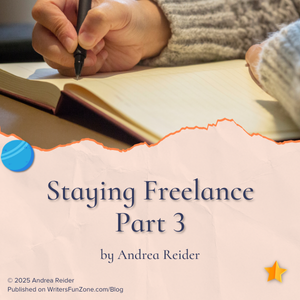Staying Freelance, Part 3 By Andrea Reider
 Let’s welcome back Andrea Reider as she shares with us “Staying Freelance, Part 3.” Enjoy!
Let’s welcome back Andrea Reider as she shares with us “Staying Freelance, Part 3.” Enjoy!
***
My father used to tell me that I was working too fast, warning me that people might take advantage of me one day for working too hard.
The pace was always hectic and pressured at the typesetting shop in Ann Arbor.
There was always more work to do then there were hours in the day.
The pace at the manufacturing company’s office was nothing like what I had experienced working for small businesses, and seemed to be like slow motion in comparison.
At first, I didn’t have nearly enough work to do to fill the day, so I spent my time trying to focus on learning more about how to use the Macintosh computer and software.
I spent many hours experimenting with the various programs installed on the computer, just seeing what I could come up with as I sat in my office waiting for the next piece of work to come in.
Ultimately, more and more people in the office became aware of the desktop publishing services that I could provide, and I found myself working hard enough to have a good sense of accomplishment at the end of most days.
I worked on a variety of corporate communication: slideshows for presentations, all types of reports, reviews, and manuals–and whatever else they could think of to throw my way.
I enjoyed working closely with the directors and managers at the company and they often expressed how appreciative they were of the work I did for them.
I had started out working full-time for the company, but after about a year of that, we came to the agreement that I would work in the office for only three days per week. This meant that I would be earning less money from this source, but it freed up a lot of time for me to pursue other types of freelance work.
My Role as a Consultant
My position as a consultant was by no means guaranteed at any point–I was an expense and had to be constantly proving my worth to the company.
It always made me nervous when I would come to the sections in the reports I was working on that called for reducing or eliminating all consultants.
And I was eliminated a couple of times, but they always called me back. But the final blow came when a new vice president of the company came on board and decided to move the headquarters to Cincinnati, Ohio.
While some of the people I worked with were relocating, most of my contacts at the company were looking for other jobs. I offered to typeset resumes at no charge for anyone who needed the service, and many people took me up on the offer.
A Highlight
One of the highlights of my time at the company came when a senior vice president came up to me in the hallway and told me that “I did the work of two men.”
He was an older gentleman and meant no disrespect in comparing me to men. I took this as high praise and was very happy to be recognized for my efforts.
My work with the company came to an end when they completed the move to Ohio.
I immediately began sending out letters and resumes to any company whose contact information I could find. Desktop publishing was a growing field and I had a fairly easy time finding freelance jobs with a variety of graphic design firms, banks, and other companies in San Francisco.
I had developed some useful skills that made me employable, but I was just at the very beginning of what would prove to be a long and challenging road to true financial stability.
Concentrating on My Freelance Business
I had offers to work as a freelancer on the premises of some companies, but I decided that I wanted to concentrate on building a freelance business that enabled me to work from home.
The many people who worked on the premises of their clients were essentially employees of the companies — but working without receiving any employment benefits.
Freelancers generally made more per hour in wages than regular employees, but in the end, I think the employees made out better than most freelancers, particularly those who worked on-site but without the benefits of being a full-time employee.
In some ways, I envied the stability that on-site freelancers had in being able to bill a single client for regular work, but they weren’t building businesses that would last beyond losing a single client.
For me, long-term success has always meant having multiple clients so that my business could survive losing any single one of them.
If I had a business strategy, it was to pursue the type of work that I enjoyed, while trying to keep increasing my income.
This turned out to be a pretty good idea as I found myself doing work that I enjoyed and was learning new skills and becoming more of a graphic designer than a production person.
Good luck to you!
***
ABOUT THE AUTHOR
 Andrea Reider has been working as a book designer and layout artist/typesetter for publishers and self-publishing authors since graduating from the University of Michigan in English in 1985 with a B.A. in English. It was the year of the Macintosh computer and “desktop publishing,” and her first job was managing a typesetting shop in Ann Arbor.
Andrea Reider has been working as a book designer and layout artist/typesetter for publishers and self-publishing authors since graduating from the University of Michigan in English in 1985 with a B.A. in English. It was the year of the Macintosh computer and “desktop publishing,” and her first job was managing a typesetting shop in Ann Arbor.
When Andrea moved to San Francisco two years later her Macintosh skills were very much in demand. Andrea began working as a freelancer for several book publishers and has been at it ever since. Her clients have included John Wiley & Sons, Addison Wesley Longman, McGraw Hill, Rowman & Littlefield, and hundreds of self-publishing authors.
Website: http://www.reiderbooks.com
Instagram: https://www.instagram.com/andreareiderdesign






